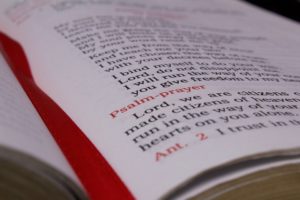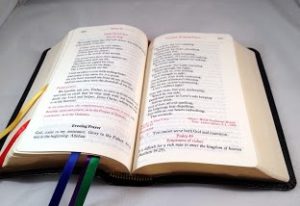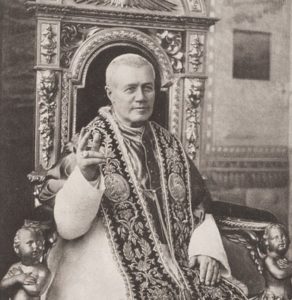 It is hard to overestimate the convenience of praying the Liturgy of the Hours from an online breviary. Not only are they convenient but they also help to lessen the complexities that often go with setting up the traditional book. For example,
It is hard to overestimate the convenience of praying the Liturgy of the Hours from an online breviary. Not only are they convenient but they also help to lessen the complexities that often go with setting up the traditional book. For example,
- Do the psalms come from the day or the Common?
- Do we use the Common of Pastors or that of the Doctors of the Church?
- Do the Advent weekday prayers and antiphons outrank the sanctoral ones?
- Is today a memorial or a feast in the U.S.?
Setting the ribbons correctly can be a challenge, and the complexity of the “rules” during the Octave of Christmas is almost nightmarish.
The availability of these breviary apps has lessened the likelihood that we are without a way to pray the Liturgy of the Hours merely because we don’t have our prayer book with us. Most of us today are rarely without our cell phone close at hand.
So, what could be the problem with using an electronic breviary? The problem is the loss of the “sacred.”
To say that something is “sacred” not only indicates that it is holy but that it has been set aside for a unique and special purpose. For example, the chalices used at Mass are not ordinary cups. They are set apart for only one special use: to contain the Precious Blood. It would be wrong to use them in the rectory for a dinner party. It would also be wrong to bring ordinary cups over from the rectory to use as “chalices” for the Precious Blood. Sacred things normally have but one use or are used only for things related to God and the worship of Him.
This also applies to sacred books and texts. In the liturgy it is expected that we normally read the prayers and readings directly from sacred books such as the Lectionary, the Book of Gospels, and the Missal; liturgists and bishops’ conferences have generally frowned upon using digital readers. For example, the bishops of New Zealand banned the use of iPads as Missals in the liturgy, explaining that because “iPads and other electronic devices have a variety of uses, e.g., playing games, using the internet, watching videos, and checking email,” the bishops have decided that “This alone makes their use in the liturgy inappropriate” [*].
Cardinal Robert Sarah, Prefect of the Congregation for Divine Worship, has a similar view: “Perhaps it is very practical to pray the breviary with my own mobile phone or tablet, but it is not worthy: it desacralizes prayer” [**]. This is not a formal instruction from him in an official capacity, but his views should elicit thoughtful consideration even when it comes to the private recitation of the Liturgy of the Hours.
 Some may consider such objections fussy or puritanical, but I think they make some sense. A sacred text, as a general norm, deserves a sacred book where it is preserved and from which it is read.
Some may consider such objections fussy or puritanical, but I think they make some sense. A sacred text, as a general norm, deserves a sacred book where it is preserved and from which it is read.
General norms are not absolute norms, so there will be exceptions, even generous ones, given the pace and mobility of modern life and the seeming need to have many things at hand. Perhaps one is traveling or wants quick reference to the texts in order to pray on a busy day. Maybe the complexity of the Divine Office, which can serve as a barrier to the laity with less liturgical background, can be overcome with the use of a cell phone app to direct prayer.
Striving to protect the general norm of keeping sacred books and texts together accomplishes certain worthy goals. Let me mention just two.
First, it reinforces the idea of the sacred, which has been so eroded today.
To some degree, our sacred actions should look, feel, sound, and be sacred or “set apart” from ordinary things. For example, church buildings should look different, sound different, even smell different from the world around them. Their essential function should be as a place for the worship of God; they should not merely be assembly halls.
The liturgy itself should have a sacral character. In the past this was emphasized by the use of Latin, particular styles of music, and specific gestures and tones of voice. Much of this has been lost today and it is often a difficult or even controversial path to bring it back. Even if the vernacular and a wider variety of music have their place, the sacred “otherness” and “set apart” quality of the Church and the liturgy has severely diminished.
Praying the breviary out of sacred books is a small step in the right direction. This is certainly more important in public recitations of the breviary, but even in our private recitation there is value in keeping that sacred time an experience that is at least somewhat “set apart” from ordinary things.
Second, it reminds us that prayer should involve some sacrifice.
We live in times when people are unduly insistent that everything should be convenient, easy, and fast—and often quick to become indignant when that is not the case.
There will be times when it is helpful to have immediate access to the breviary texts, but we ought not to forget that in biblical thinking, prayer and sacrifice are joined. The notion of prayer without sacrifice is a modern Western one. Biblical prayer involved offering a “sacrifice of praise.” Thanksgivings were made by way of sacrifices such as the offering of first fruits and libations of wine and oil.
Demands for worship that is convenient, quick, and with little cost are not usually indicative of a heart full of extravagant love (see Luke 7:44-47).
We do not want all forms of prayer and worship to become so burdensome or difficult that people avoid them, but certain small sacrifices such as using the sacred book even in private recitation of the breviary can be an act of love and a step back from the excessive insistence on convenience.
As I hold the breviary each day, I feel that I am holding God’s people in my hands as I pray for them and with the universal Church. I just don’t get that feeling when I pray using my iPhone.
More could be said, but allow this to suffice. Please accept these thoughts as general norms or observations; they are not absolutes. There are exceptions we ought not to presume that anyone who does not follow this way of thinking is impious. Every now and again, though, we do well to consider the meanings of even small actions; it is part of living a reflective life.




